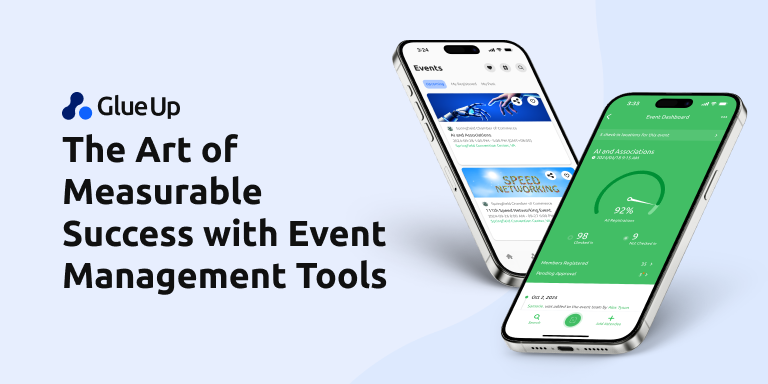
Attendee-to-Attendee Chat is one of the fastest growing trends at events, particularly larger events where it’s just not possible to meet every person there. Attendee Chat is a major breakthrough, allowing everyone to chat with everyone else, but as one might imagine, this causes problems of their own.
It’s a Pandora's box of problems that need to be solved before you push your messaging service live.
Here’s how you should be implementing attendee chat at your next event.
Choosing the Right Messenger Platform

It’s important to choose the right event management or specific messaging platform to use. Unfortunately it’s not scalable to use consumer messaging apps because these messenger network you need to host should be specific to the event only.
This leaves you with a gap that needs to be filled by a specifically event-focused messaging platform that can keep all the attendees in the network only, and not to the public.
Some neat options are:
- Glue Up
- Hollocrowd
- EventMobi
- Socio.events
- Crowd Compass by Cvent
- Group.io
- Attendify
Each provider has their own packages, benefits, and pricing models, so choose one that helps your event style the most. We always suggest just going for event platform like us here at Glue Up that has messaging inside already so all your data is in one place.
Choosing the Right Controls
Attendee Messaging is a Pandora's box. Once opened, if you’re not prepared beforehand, it can easily get out of hand, and then attendees could easily get annoyed with an overabundance of messages and requests.
Here’s a few controls put into place that can help you moderate the flow of chats during your event.
Limit Conversations

Limiting the number of conversations an attendee can have at any given time is a great way to discourage over-messaging or spam from other attendees. It also has the added benefit of forcing attendees to choose carefully who they want to talk to, encouraging more meaningful conversations rather than just “more conversations”.
Some functions to watch out for would be to the ability to delete conversations to make room for new ones, this way attendees could prioritize their communication to other attendees.
Opt-Out
Give attendees the ability to opt-out of messaging. it’ll save headaches for those that just don’t want to partake. This may include refusing all messages incoming, or better, just not making that attendee discoverable by others on the messaging platform.
This is particularly useful since VIPs at events are large targets for attention.
Create Groups

Creating groups is a smart way to get more like-minded attendees together and help draw people with common interests together. This should stir more meaningful conversations among each other rather than blasting messages into the event’s network and trying to discover your intended target audience.
A good function to look out for when it comes to groups, it whether or not being a part of a group has the ability to hide the attendee from other attendees outside of the group.
The idea here is that only attendees in a group of like minded individuals could actually earn unlimited messaging conversations at once so long as they're all part of the same group, as they could call engage in more engaging and topical discussions.
Allow Messaging Before & After
Allow Messaging before and after your events to help drive buzz before and after the event’s conclusion. This also helps attendees who discovered people of interest but didn’t quite have a chance to exchange contact info to still have an opportunity to continue their discussions online.
Allot Staff to Moderate

Sometimes you can’t always solve problems in real time like attendees getting harassed or abuse of the messaging platform, and with larger events with potentially thousands of attendees wanting a piece of the messaging service, it might be a good investment to have event staff monitor and moderate conversations and respond to reports by other attendees in real time.
Integrate Messaging to Social Media

If the option is available, make sure whatever event management solution your using can implement attendee profiles to the platform, or even better, their social media profiles to the platform.
This should help with discovery on the messaging platform as attendees could then search keywords and find the most relevant attendee to strike up a conversation. Of course, with the above said controls in-mind.
By integrating social media though, you’re opening your event up to a more public platform, which can be extremely helpful as attendees no longer need to be asked to fill up their profile manually in your preferred event platform, only to simply allow LinkedIn for instance to access your platform.
However, don't make the mistake of using actual social media walls as your go-to feed. While inevitably it will garner discussion, some lessons were learned when Agile 2013 in Nashville, Tenesse had accidentally unleashed internet trolls into their public, un-moderated social media feed on twitter using their hashtag #agile2013, where trolls left racial and violent messages for attendees to see on screens throughout the event.
The anonymity of the internet leaves a lot of opportunity for those wrong-minded individuals to disrupt your events. By having a feed internally to the event and assigning each post to a very real, very present attendee on the floor, the attention is likely deterrent enough for anyone intent to disrupt the event.
Event Feeds and Content Walls
At arm’s length,event feeds are almost directly working together with messaging tools as they can help draw or drive the conversation. Any photos the attendees want to share, a quote, an experience can be shared onto a feed within your event platform that can be seen by all attendees, or it can be segregated into any particular groups that attendee might want to dictate their posts to.
This is a semi-recent trends where events hold open feeds for attendees to contribute to so that snapshots of experiences had at events won’t be missed and can be share by anyone. This also serves as a place to generate new discussion via messaging, engaging attendees in ways similar to their own social media feeds like LinkedIn, Twitter, and FaceBook.
There are other ways to implement messaging tools, and not all are the same. However no matter the implementation method used, it behoves event planners to properly moderate the conversation flow so that attendees don’t walk away annoyed. Otherwise, attendee messaging may just be the perfect engagement point for any conference in the future.
If you’re looking to implement an engaging new event management platform in your next event, book a demo with us today and we’ll show you how Glue Up helps events grow on autopilot.



